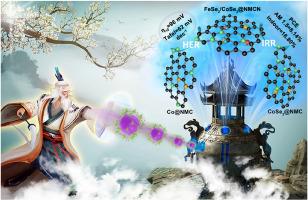通过MOF-on-MOF工程实现FeSe2/CoSe2异质结的空心碳纳米盒高效能量转换
IF 11.6
2区 材料科学
Q1 CHEMISTRY, PHYSICAL
引用次数: 0
摘要
同时优化电子结构和纳米级结构以促进界面电子转移和调整活性位点电子构型仍然是推进高效碳基电催化剂的关键。在此,我们提出了一种MOF-on-MOF界面工程策略来设计嵌入FeSe2/CoSe2异质结构的三维氮修饰碳纳米盒(FeSe2/CoSe2@NMCN)。分层结构将空心形态与多层次孔隙度相结合,建立了有效的电荷传输途径。关键是,异质界面诱导的内置电场通过界面电荷重新分配来调节d带中心,从而优化催化反应中间体的吸附能。泡沫镍电极负载的FeSe2/CoSe2@NMCN具有优异的析氢反应(HER)性能,超低过电位为96 mV (10 mA cm−2)和198 mV (100 mA cm−2)。组装的光伏器件在三碘还原反应(IRR)中实现了8.14% (AM 1.5G)和16.80% (3000 lux室内)的功率转换效率。密度泛函理论(DFT)计算进一步表明,优化催化剂的电子结构后,FeSe2/CoSe2异质界面上存在强电子相互作用,可以提高反应中间体的吸附能力。本研究通过异质结构和纳米约束效应建立了一种形态-电子双调控策略,为可持续能源系统的新型催化剂设计提供了数据和理论支持。本文章由计算机程序翻译,如有差异,请以英文原文为准。

Hollow carbon nanoboxes with FeSe2/CoSe2 heterojunctions via MOF-on-MOF engineering for efficient energy conversion
The simultaneous optimization of electronic structure and nanoscale architecture to boost interfacial electron transfer and tune active site electronic configuration remains pivotal for advancing high-efficiency carbon-based electrocatalysts. Herein, we propose a MOF-on-MOF interface engineering strategy to engineer 3D nitrogen-modified carbon nanoboxes embedded with FeSe2/CoSe2 heterostructures (FeSe2/CoSe2@NMCN). The hierarchical architecture integrates hollow morphology with multi-level porosity, establishing efficient charge transport pathways. Crucially, heterointerface-induced built-in electric fields modulate d-band centers through interfacial charge redistribution, achieving optimized adsorption energy of the catalytic reaction intermediates. FeSe2/CoSe2@NMCN loaded on a nickel foam electrode demonstrates exceptional hydrogen evolution reaction (HER) performance with ultra-low overpotentials of 96 mV (10 mA cm−2) and 198 mV (100 mA cm−2). Assembled photovoltaic devices achieve remarkable 8.14 % (AM 1.5G) and 16.80 % (3000 lux indoor) power conversion efficiencies during triiodide reduction reaction (IRR). Density functional theory (DFT) calculations further revealed strong electronic interactions at the FeSe2/CoSe2 heterointerface following optimization of the electronic structure of the catalyst, which can enhance adsorption capacities for reaction intermediates. This work establishes a morphology-electronic dual-regulation strategy through heterostructure and nano-confinement effects, providing data and theoretical support into novel catalyst design for sustainable energy systems.
求助全文
通过发布文献求助,成功后即可免费获取论文全文。
去求助
来源期刊

Carbon
工程技术-材料科学:综合
CiteScore
20.80
自引率
7.30%
发文量
0
审稿时长
23 days
期刊介绍:
The journal Carbon is an international multidisciplinary forum for communicating scientific advances in the field of carbon materials. It reports new findings related to the formation, structure, properties, behaviors, and technological applications of carbons. Carbons are a broad class of ordered or disordered solid phases composed primarily of elemental carbon, including but not limited to carbon black, carbon fibers and filaments, carbon nanotubes, diamond and diamond-like carbon, fullerenes, glassy carbon, graphite, graphene, graphene-oxide, porous carbons, pyrolytic carbon, and other sp2 and non-sp2 hybridized carbon systems. Carbon is the companion title to the open access journal Carbon Trends. Relevant application areas for carbon materials include biology and medicine, catalysis, electronic, optoelectronic, spintronic, high-frequency, and photonic devices, energy storage and conversion systems, environmental applications and water treatment, smart materials and systems, and structural and thermal applications.
 求助内容:
求助内容: 应助结果提醒方式:
应助结果提醒方式:


